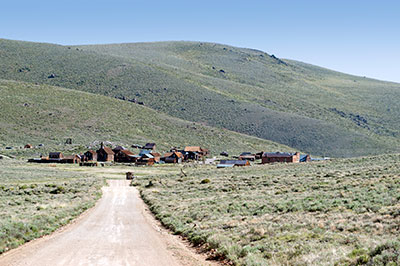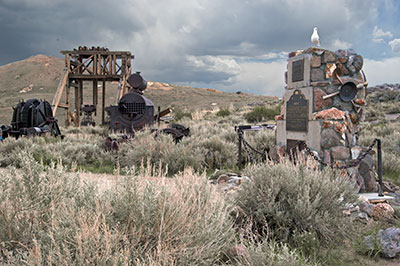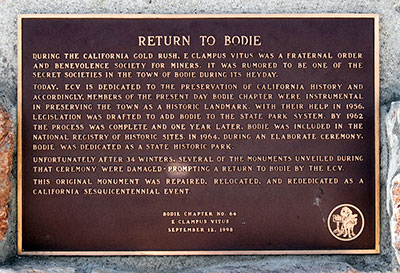Mono County Points of Interest
Bypass Road
Bodie State Historic Park
Return to Bodie
During the California Gold Rush, E Clampus Vitus was a fraternal order and benevolence society for miners. It was rumored to be one of the secret societies in the town of Bodie during its heyday.
Today, ECV is dedicated to the preservation of California history and accordingly, members of the present day Bodie Chapter were instrumental in preserving the town as a historical landmark. With their help in 1956, legislation was drafted to add Bodie to the state park system. By 1962 the process was complete and one year later, Bodie was included in the National Registry of Historic Sites. In 1964, during an elaborate ceremony, Bodie was dedicated as a State Historic Park.
Unfortunately, after 34 winters, several of the monuments unveiled during that ceremony were damaged - prompting a return to Bodie by the ECV..
This original monument was repaired, relocated, and rededicated as a California sesquicentennial event.
Bodie Chapter No. 64
E Clampus Vitus
September 12, 1998

"Return to Bodie" is the lower of the three plaques mounted on the stone base. The top plaque commemorates Bodie as a National Historic Landmark. The middle plaque commemorates Bodie as a California Historical Landmark.

What, you might ask, is a California gull doing in Bodie, on the back side of the Sierra Nevada far from the Pacific Ocean?
Well, Bodie is about twelve miles from Mono Lake as the gull flies, and Mono Lake is the largest California gull rookery in North America after the Great Salt Lake.
California gulls fly to Mono Lake each April and lay their eggs in the rocky soil. The chicks hatch in June and fledge in July. In early August, the young gulls follow their parents back to their wintering grounds. Fisherman's Wharf in San Francisco, perhaps, where the living is easy and the pickings are good.


